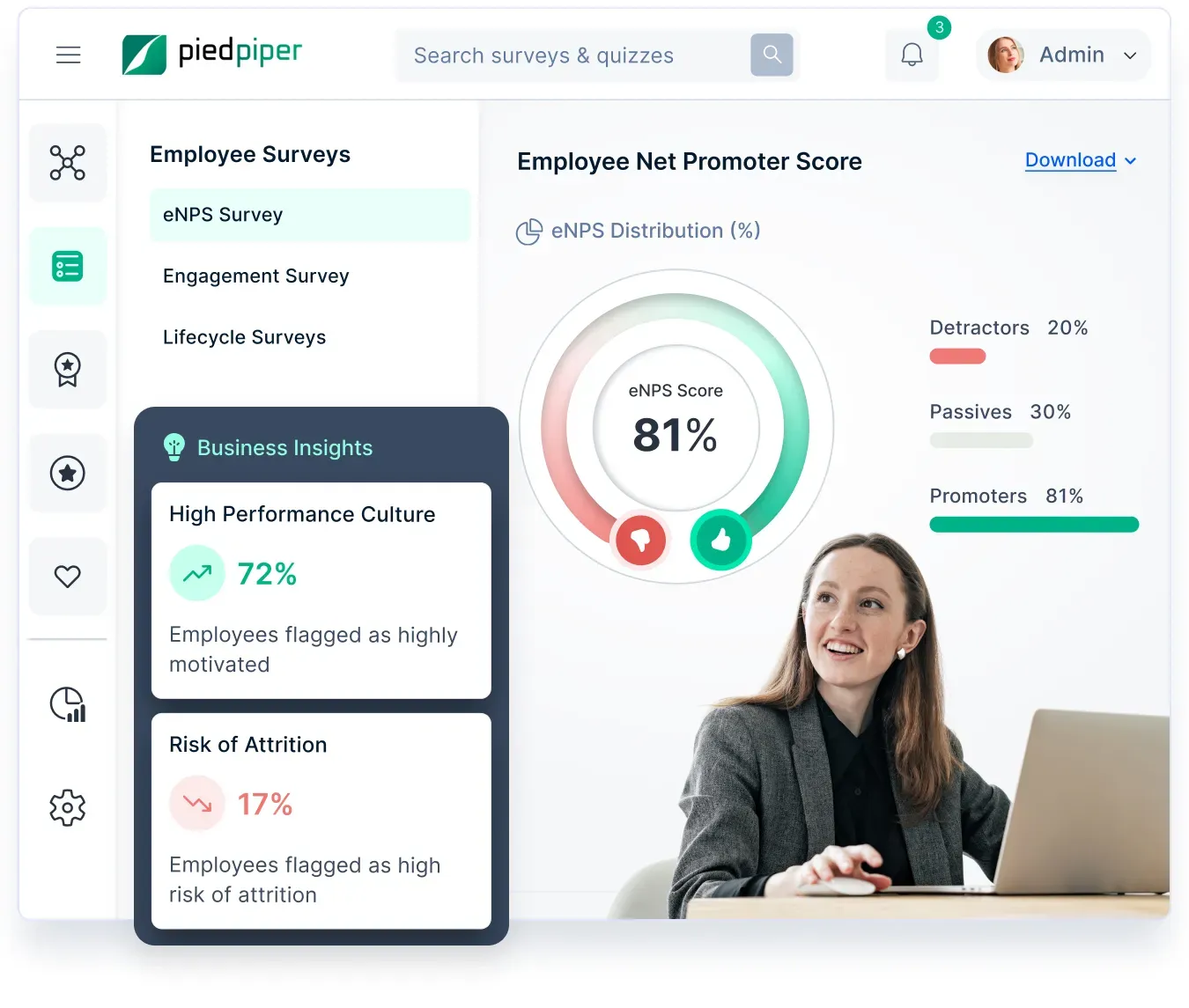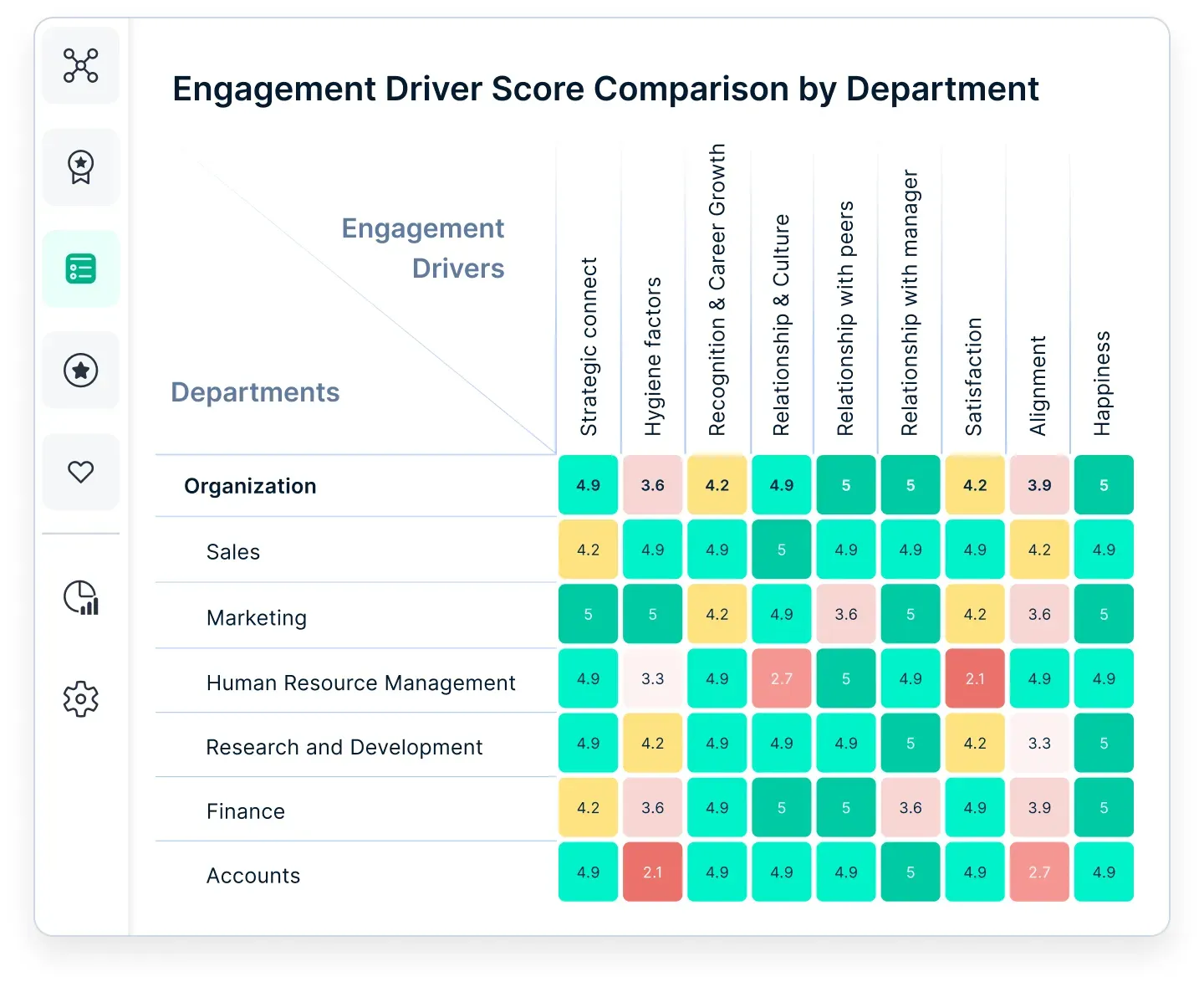Cara Melakukan Survei Keterlibatan Karyawan yang Efektif & Meningkatkan Retensi
Survei keterlibatan karyawan adalah alat yang ampuh untuk mengukur dan meningkatkan keterlibatan, produktivitas, dan retensi di tempat kerja. Panduan ini mencakup semuanya, mulai dari menyusun pertanyaan survei yang efektif hingga menganalisis hasil dan mengambil tindakan.
Di halaman ini
- Apa yang dimaksud dengan survei keterlibatan masyarakat?
- Mengapa survei keterlibatan orang penting?
- Metrik utama yang diukur dalam survei keterlibatan karyawan
- Bagaimana merancang pertanyaan survei keterlibatan karyawan Anda
- Praktik terbaik untuk melakukan survei keterlibatan karyawan
- Survei keterlibatan orang dengan Empuls
- Untuk mengakhiri
- Pertanyaan Umum
Survei keterlibatan karyawan adalah salah satu alat yang paling efektif untuk mengidentifikasi kesenjangan keterlibatan dan melakukan perbaikan berdasarkan data. Ambil contoh HubSpotsebuah perusahaan teknologi yang berkembang pesat yang berjuang dengan tingginya tingkat keluar masuk karyawan dan rendahnya semangat kerja. Meskipun telah melakukan berbagai program karyawan, mereka tidak dapat menentukan akar penyebab ketidakterlibatan.
Dengan melakukan Survei Keterlibatan Karyawan, HubSpot menemukan masalah utama seperti komunikasi yang buruk, jalur karier yang tidak jelas, dan tunjangan yang tidak selaras. Dengan menggunakan wawasan ini, mereka memperkenalkan program pengembangan terstruktur, meningkatkan komunikasi internal, dan tunjangan karyawan yang lebih baik-yang menghasilkan kepuasan yang lebih tinggi dan mengurangi pergantian karyawan.
Panduan ini akan membantu Anda merancang Survei Keterlibatan Karyawan yang mengumpulkan wawasan berharga, mengajukan pertanyaan yang tepat, dan memanfaatkan data untuk meningkatkan keterlibatan dan menciptakan tempat kerja yang berkembang.
Apa yang dimaksud dengan survei keterlibatan masyarakat?
Survei keterlibatan karyawan adalah metode terstruktur untuk mengukur seberapa terhubung, termotivasi, dan berkomitmennya karyawan terhadap organisasi mereka. Tidak seperti survei kepuasan tradisional yang menilai apakah karyawan bahagia di tempat kerja, survei keterlibatan karyawan lebih mendalam-mereka mengevaluasi komitmen emosional, antusiasme di tempat kerja, dan kemungkinan karyawan untuk melakukan lebih dari yang seharusnya dalam peran mereka.
Keterlibatan lebih dari sekadar menikmati pekerjaan-ini mencerminkan perasaan karyawan yang diinvestasikan pada misi, nilai, dan kesuksesan jangka panjang perusahaan. Survei keterlibatan karyawan yang dirancang dengan baik akan membantu tim SDM dan pimpinan:
- Mengidentifikasi kesenjangan dalam motivasi dan budaya tempat kerja sebelum hal tersebut memengaruhi retensi.
- Mengukur seberapa baik karyawan terhubung dengan pimpinan, tim, dan tujuan perusahaan.
- Lacak tren keterlibatan dari waktu ke waktu dan pastikan karyawan merasa dihargai dan didengar.
- Mengatasi masalah seperti kurangnya pertumbuhan karier, manajemen yang buruk, atau tantangan keseimbangan kehidupan kerja.
Survei keterlibatan karyawan biasanya dilakukan secara berkala, seperti triwulanan atau dua tahunan, untuk melacak perubahan keterlibatan dan memberikan umpan balik secara real-time. Organisasi yang memprioritaskan umpan balik yang berkelanjutan melalui survei ini akan lebih siap untuk mendorong kepuasan karyawan, mengurangi perputaran karyawan, dan menumbuhkan lingkungan kerja yang positif.
Mengapa survei keterlibatan orang penting?
Tenaga kerja yang tidak terlibat dapat berdampak serius pada produktivitas, retensi, dan kesuksesan bisnis secara keseluruhan. Ketika karyawan merasa tidak terhubung dengan pekerjaan mereka, mereka cenderung berkinerja buruk, mencari peluang kerja baru, atau menjadi tidak terlibat hingga pada titik di mana mereka secara mental keluar meskipun mereka tetap berada dalam organisasi.
Inilah sebabnya mengapa survei keterlibatan karyawan sangat penting-survei ini memberikan wawasan berbasis data yang membantu organisasi memahami perasaan karyawan dan mengambil langkah proaktif untuk meningkatkan keterlibatan.
Manfaat utama dari survei keterlibatan karyawan
1. Mengurangi perputaran & meningkatkan retensi
Perputaran karyawan yang tinggi itu mahal, baik dari segi biaya rekrutmen maupun hilangnya pengetahuan institusional. Survei keterlibatan membantu mengidentifikasi alasan karyawan keluar sebelum mereka mengundurkan diri, sehingga perusahaan dapat mengatasi masalah lebih awal.
2. Meningkatkan produktivitas & kinerja karyawan
Karyawan yang terlibat lebih berkomitmen terhadap pekerjaan mereka dan secara konsisten berkinerja di tingkat yang lebih tinggi. Organisasi dengan tim yang sangat terlibat akan mengalami peningkatan efisiensi, kolaborasi yang lebih baik, dan hasil bisnis yang lebih kuat.
3. Meningkatkan budaya tempat kerja & pengalaman karyawan
Budaya tempat kerja yang kuat akan menghasilkan karyawan yang lebih bahagia, yang merasa dihargai dan didukung. Survei keterlibatan membantu perusahaan memahami apa yang mendorong kepuasan di tempat kerja dan apa yang perlu ditingkatkan.
4. Memperkuat kepemimpinan & efektivitas manajerial
Karyawan tidak meninggalkan perusahaan-mereka meninggalkan manajer yang buruk. Survei keterlibatan dapat mengungkap titik-titik lemah kepemimpinan, membantu organisasi mengembangkan dukungan manajerial yang lebih baik, program pembinaan, dan pelatihan kepemimpinan.
5. Mendorong pengambilan keputusan yang didukung data
Alih-alih mengandalkan tebakan atau asumsi, survei keterlibatan memberikan data terukur yang membantu HR dan pimpinan membuat keputusan strategis yang tepat untuk meningkatkan keterlibatan karyawan.
Organisasi yang secara konsisten menjalankan survei keterlibatan karyawan dan mengambil tindakan berdasarkan hasil survei akan membangun budaya kepercayaan, transparansi, dan perbaikan berkelanjutan. Tanpa wawasan ini, perusahaan berisiko menciptakan tenaga kerja yang tidak terlibat yang mengarah pada moral yang lebih rendah, atrisi yang tinggi, dan penurunan kinerja bisnis.
Metrik utama yang diukur dalam survei keterlibatan karyawan
Survei keterlibatan karyawan yang dirancang dengan baik lebih dari sekadar kepuasan kerja secara umum - survei ini memeriksa faktor-faktor spesifik yang memengaruhi perasaan karyawan yang terlibat dan berkomitmen di tempat kerja. Dengan mengukur faktor pendorong utama keterlibatan ini, organisasi dapat menentukan apa yang berhasil, apa yang kurang, dan di mana perbaikan diperlukan.
Berikut adalah metrik utama yang harus diukur oleh survei keterlibatan karyawan yang efektif:
1. Kepuasan kerja & kebahagiaan di tempat kerja
Memahami apakah karyawan menikmati pekerjaan mereka dan merasa puas sangat penting untuk retensi dan kinerja jangka panjang. Metrik ini memeriksa:
- Apakah karyawan merasa tugas-tugas mereka bermakna dan bermanfaat.
- Seberapa puas mereka dengan peran, tanggung jawab, dan pengalaman kerja sehari-hari.
- Apakah mereka merasa termotivasi dan bersemangat dengan pekerjaan mereka.
2. Kepemimpinan & efektivitas manajerial
Manajer memainkan peran penting dalam keterlibatan karyawan. Survei harus menilai:
- Apakah karyawan mempercayai kepemimpinan mereka dan merasa selaras dengan tujuan perusahaan.
- Seberapa baik para manajer mendukung, berkomunikasi, dan memberikan umpan balik kepada karyawan.
- Apakah karyawan merasa didengar dan dihargai oleh atasan langsung mereka.
3. Peluang pertumbuhan & pengembangan karier
Karyawan ingin mengetahui bahwa mereka memiliki ruang untuk berkembang di dalam organisasi. Survei keterlibatan harus mengukurnya:
- Apakah karyawan merasa ada jalur perkembangan karier yang jelas.
- Tersedianya kesempatan belajar dan pengembangan keterampilan.
- Apakah karyawan merasa didukung dalam pertumbuhan dan aspirasi profesional mereka.
4. Keseimbangan kehidupan kerja & kesejahteraan
Kelelahan dan stres dapat secara signifikan memengaruhi keterlibatan. Survei harus menilai:
- Apakah karyawan merasa mereka dapat menjaga keseimbangan yang sehat antara pekerjaan dan kehidupan pribadi.
- Bagaimana beban kerja dan ekspektasi berdampak pada kesejahteraan mereka secara keseluruhan.
- Apakah perusahaan menyediakan dukungan kesehatan mental dan inisiatif kesehatan.
5. Pengakuan & penghargaan
Merasa dihargai adalah pendorong utama keterlibatan. Survei harus mengevaluasi:
- Apakah karyawan merasa dihargai atas pekerjaan mereka.
- Efektivitas program pengakuan dan insentif.
- Apakah karyawan percaya bahwa kontribusi mereka diakui oleh pimpinan.
6. Budaya tempat kerja & kolaborasi tim
Budaya tempat kerja yang positif dan inklusif mendorong keterlibatan. Survei harus mengukur:
- Apakah karyawan merasakan rasa memiliki dan diikutsertakan di tempat kerja.
- Betapa kolaboratif dan suportifnya tim ini.
- Apakah karyawan merasa aman untuk mengekspresikan ide dan pendapat mereka.
7. Keselarasan & tujuan organisasi
Karyawan akan lebih terlibat ketika mereka merasa terhubung dengan misi dan nilai-nilai perusahaan. Metrik ini memeriksa:
- Apakah karyawan memahami dan mendukung visi dan tujuan perusahaan.
- Apakah mereka percaya bahwa nilai-nilai perusahaan sejalan dengan nilai-nilai mereka.
- Bagaimana kepemimpinan mengkomunikasikan prioritas perusahaan dan memberi informasi kepada karyawan.
8. Skor promotor bersih karyawan (eNPS)
Metrik ini mengukur seberapa besar kemungkinan karyawan merekomendasikan organisasi sebagai tempat kerja yang baik. Nilai eNPS yang tinggi menunjukkan advokasi karyawan yang kuat, sementara nilai yang rendah menandakan masalah keterlibatan yang perlu mendapat perhatian segera.
Dengan melacak pendorong utama keterlibatan ini, organisasi dapat memperoleh wawasan yang dapat ditindaklanjuti mengenai sentimen karyawan dan membuat rencana strategis untuk meningkatkan kepuasan, kinerja, dan retensi di tempat kerja.

Mendorong Keterlibatan Karyawan dengan Wawasan yang Dapat Ditindaklanjuti
Rancang survei karyawan khusus, analisis respons dengan AI, dan buat keputusan yang didukung data untuk meningkatkan budaya tempat kerja-semuanya dengan Empuls.
Bagaimana merancang pertanyaan survei keterlibatan karyawan Anda
Saat menyusun pertanyaan Survei Keterlibatan Karyawan, fokuslah pada pertanyaan yang akan menghasilkan wawasan yang dapat ditindaklanjuti. Seperti yang ditunjukkan oleh contoh Google, Anda dapat menjalankan survei tahunan seperti "Googlegeist".
Melalui survei "Googlegeist", Google mendapatkan umpan balik tentang berbagai masalah karyawan, mulai dari tingkat kepuasan dan kinerja manajemen hingga aspek-aspek di tempat kerja. Pertanyaan-pertanyaan ini cukup terfokus untuk menginterpretasikan apa yang terjadi di lingkungan khusus ini sehingga kesimpulan yang berarti dapat diambil tentang area yang memungkinkan untuk perbaikan dan keputusan apa yang harus diambil terhadap tenaga kerjanya.
Sebagai contoh, survei Google mencakup pertanyaan yang meminta karyawan untuk menilai kepuasan mereka terhadap keseimbangan antara pekerjaan dan kehidupan pribadi, kesempatan untuk berkembang, dan tingkat kepercayaan terhadap kepemimpinan. Pertanyaan-pertanyaan ini memungkinkan Google untuk memahami tren dan menemukan tempat-tempat di mana lebih banyak fokus yang mungkin perlu ditempatkan.
Kita harus cermat dalam merancang pertanyaan survei keterlibatan karyawan untuk mendapatkan wawasan yang bermakna, berwawasan, dan dapat ditindaklanjuti. Jika tidak, jika tidak dilakukan dengan baik, maka akan menghasilkan jawaban yang tidak jelas dan data yang tidak akurat, yang mengarah pada keterlibatan yang tidak efisien.
Berikut ini adalah praktik terbaik yang dapat diikuti untuk merancang pertanyaan survei keterlibatan karyawan yang akan memberikan wawasan yang nyata:
1. Jaga agar pertanyaan tetap jelas dan ringkas
Hindari penggunaan bahasa teknis atau bahasa ahli yang dapat dengan mudah memicu kesalahan persepsi di antara para responden. Pertanyaan-pertanyaan yang diajukan harus sederhana dan langsung. Sebagai contoh, seseorang dapat bertanya: Bagaimana persepsi Anda tentang saluran komunikasi antar departemen dalam organisasi ini?
Bagaimana Anda menilai komunikasi antara departemen yang berbeda?
2. Menyeimbangkan pertanyaan kuantitatif dan kualitatif
Pertanyaan kuantitatif akan mencakup pertanyaan Likert, seperti:
Dalam skala 1-5, seberapa puaskah Anda dengan peran Anda saat ini?
Dan pertanyaan tersebut akan menghasilkan sesuatu yang dapat diukur dalam data. Pertanyaan kualitatif akan lebih terbuka dan akan terlihat seperti:
Menurut Anda, apa yang dapat ditingkatkan di departemen Anda?
Hal ini memungkinkan karyawan untuk memberikan umpan balik yang lebih panjang. Perangkat Lunak Survei Keterlibatan yang baik akan mencakup kedua pertanyaan tersebut untuk memberikan gambaran yang lebih lengkap tentang keterlibatan karyawan.
3. Hindari pertanyaan yang mengarahkan atau pertanyaan dengan bias
Pastikan bahwa semua pertanyaan Anda disusun secara netral dan tidak akan menimbulkan respons tertentu dari responden. Sebagai contoh, pertanyaan utama adalah:
Bagaimana pendapat Anda tentang praktik manajemen yang baik di perusahaan kami?
Dengan asumsi praktik-praktik yang baik dalam manajemen. Lebih baik bertanya,
Bagaimana pendapat Anda tentang praktik manajemen perusahaan kami?
4. Fokus pada pendorong keterlibatan utama
Rancanglah pertanyaan-pertanyaan yang ditargetkan pada area-area penting yang mempengaruhi keterlibatan: kepuasan dengan pekerjaan seseorang, hubungan dengan manajer lini, kesempatan untuk berkembang di dalam organisasi, keseimbangan antara pekerjaan dan kehidupan pribadi, serta penghargaan adalah area-area utama. Ini adalah area-area yang dapat dirancang pertanyaan-pertanyaannya, yang memberikan wawasan tentang faktor-faktor penting yang mempengaruhi keterlibatan.
5. Survei pengujian
Sebelum mengirimkan Perangkat Lunak Survei Keterlibatan Anda ke seluruh perusahaan, ujilah dengan sekelompok kecil karyawan. Hal ini akan memungkinkan Anda untuk mengetahui pertanyaan-pertanyaan yang membingungkan atau tidak jelas sehingga Anda dapat menyesuaikannya sebelum seluruh peluncuran selesai.
Praktik terbaik untuk melakukan survei keterlibatan karyawan
Membuat survei keterlibatan karyawan yang terstruktur dengan baik hanyalah langkah pertama-bagaimana Anda melaksanakannya akan menentukan kualitas tanggapan dan efektivitas wawasan yang dikumpulkan. Survei yang dilaksanakan dengan buruk dapat menyebabkan rendahnya partisipasi, tanggapan yang tidak akurat, dan ketidakpercayaan di antara karyawan. Untuk memastikan keterlibatan yang tinggi, umpan balik yang jujur, dan hasil yang dapat ditindaklanjuti, ikuti praktik-praktik terbaik berikut ini:
1. Tetapkan ekspektasi dengan komunikasi yang jelas
Karyawan akan lebih mungkin berpartisipasi jika mereka mengerti:
- Mengapa survei ini dilakukan (misalnya, meningkatkan budaya tempat kerja, pengembangan karier, dukungan kepemimpinan).
- Bagaimana hasilnya akan digunakan untuk mendorong perbaikan di tempat kerja.
- Perubahan apa yang dapat diharapkan oleh karyawan berdasarkan umpan balik yang mereka berikan.
2. Menjamin anonimitas untuk tanggapan yang jujur
Karyawan mungkin ragu-ragu untuk memberikan umpan balik yang jujur jika mereka takut akan dampaknya. Untuk membangun kepercayaan:
- Gunakan platform survei pihak ketiga yang memastikan anonimitas.
- Hindari meminta informasi yang dapat diidentifikasi secara pribadi.
- Mengagregasi hasil berdasarkan departemen atau tim alih-alih menampilkan respons individu.
3. Jaga agar survei tetap singkat dan terfokus
Kelelahan survei adalah hal yang nyata, survei yang rumit sering kali menyebabkan respons yang setengah hati atau putus asa.
- Buatlah 10-20 pertanyaan yang terstruktur dengan baik.
- Pastikan survei membutuhkan waktu tidak lebih dari 5-10 menit untuk diselesaikan.
- Memprioritaskan pendorong keterlibatan utama seperti kepemimpinan, budaya kerja, dan kepuasan kerja.
4. Pilih waktu yang tepat
Waktu pelaksanaan survei itu penting. Hindari meluncurkan survei:
❌ Selama periode beban kerja puncak (misalnya, akhir tahun fiskal, tenggat waktu proyek besar).
Tepat setelah PHK atau perubahan struktural yang signifikan, karena emosi dapat mempengaruhi hasil.
✅ Idealnya, lakukan survei selama periode yang stabil ketika karyawan dapat merespons dengan baik.
5. Membuat partisipasi menjadi mudah
Semakin mudah survei diakses, semakin tinggi tingkat partisipasi. Memastikan:
- Survei ramah seluler sehingga karyawan dapat menyelesaikannya di perangkat apa pun.
- Platform survei ini terintegrasi dengan alat bantu di tempat kerja seperti Slack, Microsoft Teams, atau portal HR.
- Karyawan dapat berhenti sejenak dan melanjutkan survei jika mereka membutuhkan lebih banyak waktu untuk menjawab dengan penuh pertimbangan.
6. Mendorong dukungan kepemimpinan & manajerial
Ketika karyawan melihat para pemimpin secara aktif mempromosikan survei, mereka lebih mungkin untuk terlibat.
- Dorong manajer untuk mendiskusikan survei dengan tim mereka dan tekankan pentingnya survei tersebut.
- Mintalah para pemimpin senior untuk secara pribadi mengundang karyawan untuk berpartisipasi.
- Tunjukkan komitmen dengan membagikan hasil survei sebelumnya dan tindakan yang diambil untuk membangun kepercayaan.
7. Bertindak berdasarkan umpan balik & menutup lingkaran
Tidak ada yang lebih merusak kepercayaan daripada hasil survei yang diabaikan. Setelah umpan balik dikumpulkan:
- Menganalisis hasil secara menyeluruh, mengidentifikasi tren, kekuatan, dan area masalah.
- Bagikan temuan-temuan tersebut kepada karyawan, rangkum wawasan utama secara transparan.
- Kembangkan rencana aksi dengan langkah-langkah konkret untuk mengatasi masalah dan meningkatkan keterlibatan.
Survei keterlibatan karyawan hanya bernilai sama berharganya dengan tindakan yang diinspirasikannya. Mengikuti praktik-praktik terbaik ini memastikan survei Anda mengumpulkan wawasan yang bermakna, mendorong partisipasi yang jujur, dan mendorong perbaikan di tempat kerja yang membuat karyawan merasa didengar dan dihargai.
Survei keterlibatan orang dengan Empuls

Survei keterlibatan karyawan yang sukses lebih dari sekadar mengumpulkan umpan balik - survei ini harus menghasilkan wawasan yang dapat ditindaklanjuti, peningkatan tempat kerja yang berarti, dan budaya organisasi yang lebih kuat. Di sinilah Empuls menonjol sebagai platform keterlibatan karyawan yang komprehensif yang membantu organisasi merancang, mendistribusikan, menganalisis, dan menindaklanjuti hasil survei secara efektif.
Mengapa Memilih Empuls?
✅ Survei yang dapat disesuaikan dan didukung oleh penelitian: Gunakan survei keterlibatan yang telah dibuat sebelumnya atau yang disesuaikan yang didukung oleh model SHRM dan Gallup Q12.
✅ Analisis sentimen berbasis AI: Identifikasi tren, risiko, dan pendorong keterlibatan utama dengan wawasan waktu nyata.
✅ Survei denyut nadi & siklus hidup otomatis: Jalankan survei pulsa triwulanan, survei orientasi, dan wawancara keluar dengan mudah.
✅ Integrasi yang mulus: Lakukan survei secara langsung di Slack, Microsoft Teams, dan platform HRIS seperti BambooHR dan Workday.
✅ Laporan yang dapat ditindaklanjuti & dorongan dari manajer: Dapatkan rekomendasi yang didukung AI dan pedoman keterlibatan untuk memandu tindakan pimpinan.
✅ Dukungan yang ramah seluler & multi-bahasa - Memastikan partisipasi yang tinggi di seluruh tim global
Dengan Empuls, organisasi bergerak lebih dari sekadar survei untuk membangun budaya berbasis umpan balik yang meningkatkan keterlibatan dan retensi.
👉 Mulailah mengukur keterlibatan dengan Empuls sekarang!
Untuk mengakhiri
Survei keterlibatan karyawan yang dirancang dengan baik lebih dari sekadar alat bantu-ini merupakan pendekatan strategis untuk membangun tenaga kerja yang termotivasi, berkomitmen, dan berkinerja tinggi. Organisasi yang secara konsisten mengukur dan menindaklanjuti umpan balik dari karyawan akan menciptakan budaya kepercayaan, transparansi, dan perbaikan berkelanjutan.
Untuk membuat survei keterlibatan benar-benar efektif:
- Ajukan pertanyaan yang tepat untuk mengungkap wawasan yang bermakna.
- Pastikan anonimitas untuk mendorong umpan balik yang jujur.
- Menindaklanjuti hasil dengan mengimplementasikan perbaikan yang nyata.
- Lacak kemajuan dari waktu ke waktu dengan survei denyut nadi lanjutan.
Dengan Empuls, organisasi dapat melakukan lebih dari sekadar pengumpulan data untuk mendapatkan wawasan real-time, mendorong keterlibatan, dan membangun tempat kerja yang berkembang. Berinvestasi dalam survei keterlibatan karyawan bukan hanya tentang mengukur kepuasan-ini adalah tentang menciptakan tempat kerja di mana karyawan merasa didengar, dihargai, dan diberdayakan untuk sukses.
Pertanyaan Umum
Mengapa melakukan survei keterlibatan karyawan?
Mereka membantu mengidentifikasi area-area ketidakpuasan karyawan dan dengan demikian meningkatkan retensi, produktivitas, dan moral di tempat kerja secara keseluruhan.
Apa saja pertanyaan yang dapat dimasukkan dalam survei keterlibatan karyawan?
Termasuk di dalamnya kepuasan kerja, efektivitas manajer, keseimbangan kehidupan kerja, dan pertanyaan-pertanyaan tentang pengembangan bakat.
Bagaimana cara memilih perangkat lunak survei yang tepat?
Carilah fitur-fitur seperti desain yang ramah pengguna, analisis yang kuat, dan keamanan data yang kuat-apa pun yang sesuai dengan kebutuhan perangkat lunak Anda.
Bagaimana cara mendapatkan partisipasi yang tinggi dalam survei?
Tekankan kepada karyawan akan pentingnya survei ini, pastikan anonimitasnya, dan buatlah survei ini dapat diakses dengan mudah untuk memaksimalkan partisipasi.












